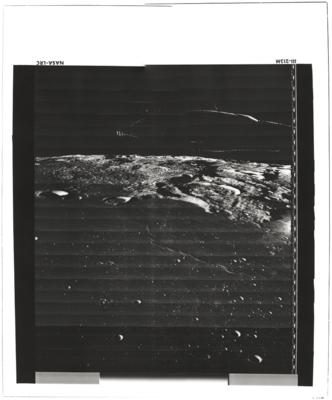NASA (Lunar Orbiter III)
Stark lunar horizon at the terminator, Ocean of Storms, May 1967
Large-format vintage gelatin silver print on fiber-based paper, printed 1967, numbered "NASA LRC III-213M" (NASA Langley) in black in bottom margin, 51 x 61 cm, several creases and 1 tear in the upper right margin
One of the very few oblique views showing the lunar horizon taken by the Lunar Orbiter spacecraft.
The low altitude of only 58.98 km of the spacecraft, high oblique view and the low Sun elevation near the terminator emphasize details of the relief in this breathtaking photograph taken with the wide angle 80mm lens looking southwest toward the southwest rim of the Ocean of Storms including Crater Damoiseau (latitude: 3.33°S; longitude: 59.78°W).
"The moderate-resolution photograph on this page was taken by Lunar Orbiter III on February 22, 1967, at an altitude of 35 miles, near the point 1° N, 58° W, in the southern part of Oceanus Procellarum, looking generally southwestward.
This particular photograph was taken to determine whether the innermost crater, Damoiseau, of the large, double-walled crater at right center is a collapsed volcanic structure, as it appears to be from Earth-based telescopic observations. According to scientists of the U.S. Geological Survey, this oblique photo alone is not conclusive. However, a careful review of another Orbiter III photograph of the same area, a vertical view, indicates that the inner crater is indeed a collapsed volcanic crater and the outer wall the remnant of an older, impact crater.
Another interesting aspect of this photograph is the contact between the marelike material in the foreground and the steep, semicircular cliff at its far edge. This headland has extremely steep sides, yet there is very little evidence of slumping at the base. This suggests that the mare material has flooded an old crater, its near rim already worn away by meteorite impact or submerged in general tilting."
Norman L. CRABILL, of Langley Research Center, NASA,(Exploring Space with a Camera (NASA SP-168), Cortright, ed., pg. 101.)
Literature:
Exploring Space with a Camera (NASA SP-168), Cortright, ed., pg. 101.
Esperta: Mag. Eva Königseder
 Mag. Eva Königseder
Mag. Eva Königseder
+43-1-515 60-421
eva.koenigseder@dorotheum.at
27.09.2023 - 14:44
- Prezzo realizzato: **
-
EUR 390,-
- Stima:
-
EUR 800,- a EUR 1.200,-
- Prezzo di partenza:
-
EUR 100,-
NASA (Lunar Orbiter III)
Stark lunar horizon at the terminator, Ocean of Storms, May 1967
Large-format vintage gelatin silver print on fiber-based paper, printed 1967, numbered "NASA LRC III-213M" (NASA Langley) in black in bottom margin, 51 x 61 cm, several creases and 1 tear in the upper right margin
One of the very few oblique views showing the lunar horizon taken by the Lunar Orbiter spacecraft.
The low altitude of only 58.98 km of the spacecraft, high oblique view and the low Sun elevation near the terminator emphasize details of the relief in this breathtaking photograph taken with the wide angle 80mm lens looking southwest toward the southwest rim of the Ocean of Storms including Crater Damoiseau (latitude: 3.33°S; longitude: 59.78°W).
"The moderate-resolution photograph on this page was taken by Lunar Orbiter III on February 22, 1967, at an altitude of 35 miles, near the point 1° N, 58° W, in the southern part of Oceanus Procellarum, looking generally southwestward.
This particular photograph was taken to determine whether the innermost crater, Damoiseau, of the large, double-walled crater at right center is a collapsed volcanic structure, as it appears to be from Earth-based telescopic observations. According to scientists of the U.S. Geological Survey, this oblique photo alone is not conclusive. However, a careful review of another Orbiter III photograph of the same area, a vertical view, indicates that the inner crater is indeed a collapsed volcanic crater and the outer wall the remnant of an older, impact crater.
Another interesting aspect of this photograph is the contact between the marelike material in the foreground and the steep, semicircular cliff at its far edge. This headland has extremely steep sides, yet there is very little evidence of slumping at the base. This suggests that the mare material has flooded an old crater, its near rim already worn away by meteorite impact or submerged in general tilting."
Norman L. CRABILL, of Langley Research Center, NASA,(Exploring Space with a Camera (NASA SP-168), Cortright, ed., pg. 101.)
Literature:
Exploring Space with a Camera (NASA SP-168), Cortright, ed., pg. 101.
Esperta: Mag. Eva Königseder
 Mag. Eva Königseder
Mag. Eva Königseder
+43-1-515 60-421
eva.koenigseder@dorotheum.at
|
Hotline dell'acquirente
lun-ven: 10.00 - 17.00
kundendienst@dorotheum.at +43 1 515 60 200 |
| Asta: | The Beauty of Space - Iconic Photographs of Early NASA Missions |
| Tipo d'asta: | Asta online |
| Data: | 27.09.2023 - 14:44 |
| Luogo dell'asta: | Wien | Palais Dorotheum |
| Esposizione: | Online |
** Prezzo d’acquisto comprensivo dei diritti d’asta acquirente e IVA
Non è più possibile effettuare un ordine di acquisto su Internet. L'asta è in preparazione o è già stata eseguita.

